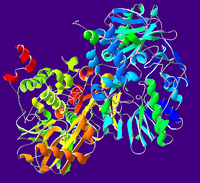Assessment |
Biopsychology |
Comparative |
Cognitive |
Developmental |
Language |
Individual differences |
Personality |
Philosophy |
Social |
Methods |
Statistics |
Clinical |
Educational |
Industrial |
Professional items |
World psychology |
Biological: Behavioural genetics · Evolutionary psychology · Neuroanatomy · Neurochemistry · Neuroendocrinology · Neuroscience · Psychoneuroimmunology · Physiological Psychology · Psychopharmacology (Index, Outline)
| ||||||||||||||||||||||||||||||||
Monoamine oxidases (singular abbreviation MAO) (EC 1.4.3.4) are enzymes that catalyze the oxidation of monoamines. They are found bound to the outer membrane of mitochondria in most cell types in the body. The enzyme was discovered by Mary Hare in the liver, and received the name of tyramine oxidase.[1] They belong to protein family of flavin containing amine oxidoreductases.
Locations of MAO-A and MAO-B
In humans there are two types of MAO: MAO-A and MAO-B.
- Both are found in neurons and astroglia.
- Outside the central nervous system:
- MAO-A is also found in the liver, gastrointestinal tract and placenta.
- MAO-B is mostly found in blood platelets.
Function
Monoamine oxidases catalyze the oxidative deamination of monoamines. Oxygen is used to remove an amine group from a molecule, resulting in the corresponding aldehyde and ammonia. The general form of the catalyzed reaction (with R denoting an arbitrary group) is
H H
R-C-NH2 + O2 + H2O → R-C=O + NH3 + H2O2
H
Monoamine oxidases contain the covalently-bound cofactor FAD and are thus classified as flavoproteins.
Subtype Specificities
MAO-A is particularly important in the catabolism of monoamines ingested in food. Both MAOs are also vital to the inactivation of monoaminergic neurotransmitters, for which they display different specificities.
- Serotonin, norepinephrine (noradrenaline), and epinephrine (adrenaline) are mainly broken down by MAO-A.
- Phenethylamine is broken down by MAO-B.
- Both forms break down dopamine.
Disorders resulting from MAO dysfunction
Because of the vital role that MAOs play in the inactivation of neurotransmitters, MAO dysfunction (too much/too little MAO activity) is thought to be responsible for a number of neurological disorders. For example, unusually high or low levels of MAOs in the body have been associated with depression, substance abuse, attention deficit disorder, and irregular sexual maturation. Monoamine oxidase inhibitors are one of the major classes of drug prescribed for the treatment of depression, although they are last line treatment due to risk of the drug's interaction with diet or other drugs. Excessive levels of catecholamines (epinephrine, norepinephrine, and dopamine) may lead to a hypertensive crisis, and excessive levels of serotonin may lead to serotonin syndrome.
PET research has shown that MAO is also heavily depleted by use of tobacco cigarettes.[2]
Genetics
The genes encoding MAO-A and MAO-B are located side-by-side on the short arm of the X chromosome, and have about 70% sequence similarity. Rare mutations in the gene are associated with Brunner syndrome.
A study reported in Science in August 2002 concluded that maltreated children with a low-activity polymorphism in the promoter region of the MAO-A gene were more likely to develop antisocial conduct disorders than maltreated children with the high-activity variant.[3] The suggested mechanism for this effect is the decreased ability of those with low MAO-A activity to quickly degrade norepinephrine, the synaptic neurotransmitter involved in sympathetic arousal and rage. This is alleged to provide direct support for the idea that genetic susceptibility to disease is not determined at birth, but varies with exposure to environmental influences.
Research also uncovered a possible link between predisposition to novelty seeking and a genotype of the MAO-A gene.[4]
In 2006, a New Zealand researcher, Dr Rod Lea said that a particular variant (or genotype) was over-represented in Māori, a Warrior gene. This supported earlier studies finding different proportions of variants in different ethnic groups. This is the case for many genetic variants, with 33% White/Non-Hispanic, 61% Asian/Pacific Islanders having the low-activity MAO-A promoter variant.[5]
See also
- Monoamine oxidase inhibitor
- Genetics and violence
- Neophilia
- Warrior gene
- Brunner syndrome
References
- ↑ Hare MLC (1928) Tyramine oxidase. I. A new enzyme system in liver. Biochem J 22:968Y979
- ↑ Fowler JS, Volkow ND, Wang GJ, Pappas N, Logan J, MacGregor R, Alexoff D, Wolf AP, Warner D, Cilento R, Zezulkova I (1998). Neuropharmacological actions of cigarette smoke: brain monoamine oxidase B (MAO B) inhibition.. Journal of addictive diseases.
- ↑ Caspi A, McClay J, Moffitt T, Mill J, Martin J, Craig I, Taylor A, Poulton R (2002). Role of genotype in the cycle of violence in maltreated children. Science 297 (5582): 851-4.
- ↑ The disorder of these times, neophilia, by Heidi Dawley, published June 18, 2006, retrieved on May 22, 2007
- ↑ Sabol S, Hu S, Hamer D (1998). A functional polymorphism in the monoamine oxidase A gene promoter. Hum Genet 103 (3): 273-9.
External links
- MAO-B Structure at eurekalert.org
- Calculated orientations of Monoamine oxidases in membrane
- Monoamine oxidase (MAO) at bmc.uu.se
- Slides showing the effects of tobacco smoking on MAO at nida.nih.gov
- Foods to avoid when taking MAO inhibitors at lycaeum.org
- Information Hyperlinked Over Proteins -- MAO-A
Template:CH-NH2 oxidoreductases Template:Mitochondrial enzymes
| This page uses Creative Commons Licensed content from Wikipedia (view authors). |
